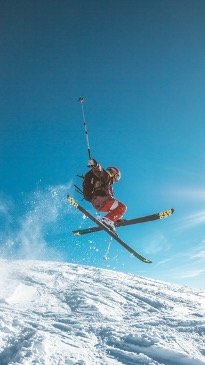Colby Russell Robbins of Tennessee, when not engaged in work as a CFP, is an avid skier logging in dozens of hours on the slopes each season. Below, Colby discusses the top training methods used by professionals and top-level athletes to continually improve their skills.
Ever wondered what it takes to go from cruising the bunny slopes to flying down a double black diamond hill? It all comes down to strict training protocols, which allow for increased comfort and skill on more challenging slopes.
Colby Russell Robbins of Tennessee says athletes must develop a variety of necessary skill sets to navigate unpredictable terrain and increase speed and precision. These skills are essential to professional competition environments.
Keep reading for further insight into the training lifestyle and the emphasized skills practiced by professionals.
Time and Practice
Colby Russell Robbins of Tennessee explains that Olympic professionals gain their abilities from the intense, consistent time spent on the slopes. Whether in the gyms or the snow, advanced skiers spend lots of time working out and practicing different skills needed while going down the hills.
The typical amount of days spent per year practicing or competing is
130-150. These days contain multiple runs a day and include various drills and workouts involved. There must also be variety within training such as straight skiing vs. turns and different inclines. An athlete will make anywhere between 3-6 runs a day during a training period.
Professionals typically start picking up the sport from their adolescent years and make the training more intense throughout their development. Colby Russell Robbins of Tennessee explains that while most protocols will have easier schedules and exercises for younger athletes, the process eventually becomes more involved and intensive training.
Gym
Not all training takes place out in the snow — Colby Russell Robbins of Tennessee says that a significant portion exists within the gym. With the incredible amount of muscle and flexibility required to be a great skier, there's work to be done beyond skill, such as sculpting and pushing the body.
Some essential areas that need to be worked out are the core, legs, and flexibility. Olympic skiers might not be competing in bodybuilding, but they'll be lifting weights and building up muscles that will make them better athletes in competition.
Many exercises can improve the previously mentioned areas, but some examples are front planks, jump squats, and any form of cardio. However, Colby Russell says the training is always adjusted to individual skiers' needs and may need to account for any chronic injuries they have faced previously.
This conditioning goes a long way in improving the power, endurance, and stability more directly than only skiing can do.
Carving
Colby Russell Robbins of Tennessee explains this phrase refers to a method or style of skiing, but it can also be a priority when training. Carving refers to leaning towards the hill to cut across it and reach the gates. This skill enables you to maneuver around the slope to get to the next gate without a struggle.
Carving is also used to gain more control while on a run and is primarily for races. You have to tilt your skis while balancing on the outside one to carve. It's all in the angles, balance, and going against the fall line.
This skill can be improved upon and learned by
doing some drills, making the difficult positions easier. Example drills are side slipping, outside ski, and railroad tracks.


Pole Planting
When using poles on the slopes, the planting method can influence how you make and calculate turns. Your poles are essential tools to guide you through turns, but they rely on proper timing. If you use them too early or late, it'll interfere with their effectiveness or render them entirely useless according to Colby Russell Robbins of Tennessee.
You should always plant your pole at a forty-five-degree angle in relation to your ski. This technique takes lots of practice to perfect but will make a monumental difference in your skills and ability to make calculated turns across the slope.
Pole planting also aids in regulating speed but requires that users maintain proper angled positions and have poles that match their height. Professional athletes must perfect the use of poles because they're at a significant disadvantage to fellow skiers without them.
The Results of Training
Colby Russell Robbins of Tennessee reports that the process of training professionally for skiing is intensive and comprised of many exercises and essential techniques. The athlete's body needs to be prepared for the snow and ready to make special moves to maintain control over turns and speed.
Whatever training style works for someone will vary depending on the desired goal. However, the training behind the sport is far more in-depth than just skiing many hours a day. Professional skiers must be dedicated to improving their overall athleticism while learning a variety of skiing techniques.
But between all the hours in the gym and the time spent on drills, what we get is talented athletes who carve up the slopes with incredible precision and power.

